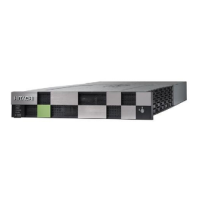Procedure
1. Expand the Stor
age Systems tree, and then click Reports.
2. Specify the report to download.
3. Click Download Reports.
4. Specify a folder in which to save a .tgz le.
5. Extr
act the downloaded .tgz le.
6. Display the report.
For HTML reports:
Open the le extracted-folder\html\index.html.
For CSV reports:
Open a CSV le in the folder extracted-folder\csv.
Viewing configuration reports in the Reports window
Y
ou can view only HTML format reports in the Reports window.
Procedure
1. Expand the Storage Systems tree, and then click Reports.
2. Click the name of the report to display.
The report is displayed in the Reports window.
3. In the Reports window, click the name of the report in the list at the left, and then
view the report at the right.
Creating configuration reports
You can create up to 20 conguration reports for each storage system. If you already
cr
eated 20 reports, delete unnecessary reports rst, and then create a new report.
Note: If you use the conguration setting (raidcom) command of C
CI to
create parity groups and LDEVs, click File > Refresh All to update the
conguration information before creating a conguration report.
Before you begin
You must have Storage View permission to perform this task.
Procedure
1. Open the Create Conguration Report window. From General Tasks, click Create
Conguration Report.
2. Specify a task name and click Apply. This task name is used as the report name in
the Reports window. This process takes approximately 10 minutes to complete.
3. Click Refresh to update the Reports window. The created report appears in the list.
Deleting configuration reports
You can delete a conguration report when you no longer need it, or to make room in
the Reports window when the number of reports is near the limit.
Viewing conguration reports in the Reports window
Chapter 9: Managing storage system reports
System Administrator Guide for VSP Gx00 models and VSP Fx00 models 204

